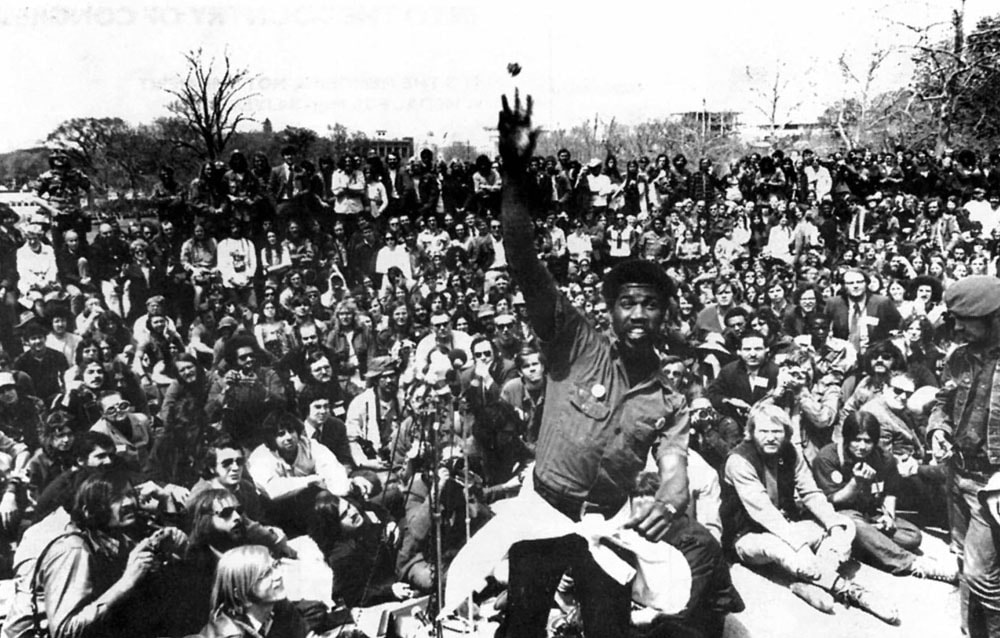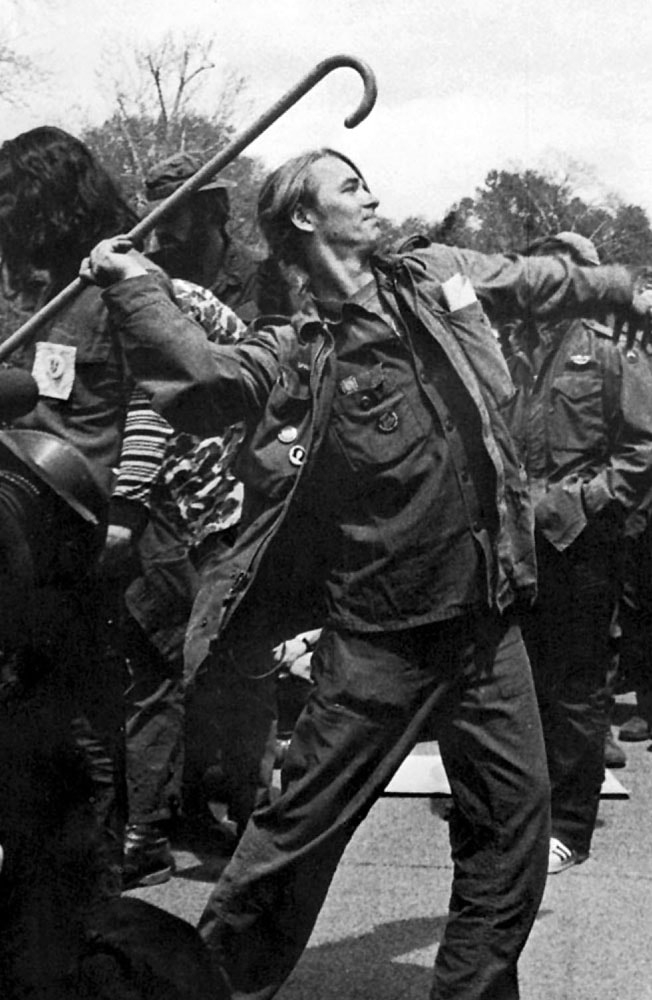|
A little less than fifty years ago in 1971, over 800 Vietnam War veterans gathered in Washington, D.C. and ceremonially threw their medals, ribbons, and other markers of military valor onto the grounds in front of the Capitol. The veterans were there to protest the brutal and unwinnable war that the United States was perpetrating in Vietnam, Laos, and Cambodia -- the war in which those veterans earned those medals and ribbons in the first place. The story of the veterans throwing away their military honors in protest made the front page of newspapers across the country, including The New York Times, but the memory of that dramatic demonstration has largely been forgotten, the significance of the event lost, and the event itself replaced with misleading and wrongful myths about veterans’ active roles in the antiwar movement.
It is a long-standing misconception that antiwar activists and war veterans are fundamentally at odds with each other, but even just a glance at the history quickly dispels the notion. The myth of antiwar protesters spitting on returning veterans has been effectively disproven, and one of the earliest and most popular slogans in the Vietnam era movement was “bring our boys home.” Antiwar activists have always directed criticism on the political and military leadership, not the soldiers themselves; in fact, much of antiwar activity centers around supporting active-duty soldiers and veterans as they struggle with what they have been forced to do in the military. For example, the Committee for Nonviolent Action, which founded the original iteration of the Voluntown Peace Trust, offered military counseling and support for resisters. But veterans were not merely passive victims; they themselves ultimately became leaders in the antiwar movement. Exactly 55 years ago, twenty recently discharged veterans joined an antiwar protest in New York City under a banner which read: “Vietnam Veterans Against War.” Later that day, six of those veterans decided to start a formal organization to give voice to other veterans who had come to oppose the war like themselves: Vietnam Veterans Against the War (VVAW). As the war continued, membership in the organization grew, especially after a few shocking events. On April 28, 1970, President Nixon authorized US troops to cross into neutral Cambodia, illegally extending the war. Days later at Kent State University, the National Guard fired about 67 live rounds with no immediate provocation at student antiwar protesters, killing four students and injuring nine more. The massacre triggered more protests across the country and thousands to join VVAW. A few months later, over Labor Day weekend in September, VVAW conducted Operation RAW (Rapid American Withdrawal). Over 200 VVAW members, accompanied by members of other antiwar groups, marched from Morristown, New Jersey to Valley Forge State Park in Pennsylvania. Organizers had planted actors in towns along the route beforehand. When the VVAW would arrive in a town along the march route, they would conduct dramatized “search and destroy” missions with the actors, bringing the Vietnamese civilian’s war experience to American small towns’ streets. Operation RAW concluded with a four-hour rally at which future Presidential candidate John Kerry, civil rights leader Rev. James Bevel, and actor-activist Jane Fonda and other speakers addressed a crowd of over 1500. VVAW sponsored actions, investigations, and other projects to support those left out in the cold by the Veterans’ Affairs office. VVAW also continued to educate the American public about the horrible realities of the war. To serve both ends, from January 1971 to February 1972, VVAW sponsored the Winter Soldier Investigation into American war crimes that U.S. veterans witnessed or were forced to commit. The project was meant to expose the military’s lies that hideous massacres like at the village of My Lai were extraordinary cases. According to the testimonies of 109 Vietnam veterans, such atrocities committed by U.S. Armed Forces were routine. Although the testimonies were ultimately entered into the Congressional record and submitted to the Department of Defense to be used in an internal investigation, the Winter Soldier Investigation was the target of a media blackout. Therefore, the veterans’ testimonies never reached the wider public as organizers had hoped. The VVAW action in April of 1971 outside the U.S. Capitol was harder to ignore. Named “Operation Dewey Canyon III” after a series of intense U.S. Marine invasions into Laos, participants ironically described it as “a limited incursion into the country of Congress.” On April 19, 1971, the American Gold Star Mothers (an organization for American mothers whose children died in service of the U.S. military) led over 1100 veterans to the Tomb of the Unknown Soldier at Arlington National Cemetery. The gates had been closed and locked before the march arrived, but that did not stop the group from holding a memorial service for the lives lost on all sides of the conflict. Over the next few days, VVAW would perform more guerilla theater search and destroy missions, attempt to surrender to the Pentagon as war criminals, and lobby congressional representatives about ending the war. VVAW spokesperson John Kerry addressed the Senate Foreign Relations Committee for two hours to testify against the war. Patriotic songs were sung. A candlelight vigil was held. The veterans also defied an injunction against camping on the National Mall and prepared themselves to be detained for it, but were pleasantly surprised when park police refused orders to make any arrests. A group of 106 veterans were later arrested for protesting the injunction on the steps of the Supreme Court, but were shortly thereafter released. Finally, on Friday, April 23, about 800 veterans lined up before the U.S. Capitol. After four days of anxiety and dramatic action, the veterans had had enough. The original plan was to put the medals, ribbons, and other military memorabilia into a body bag to deposit at the Capitol, but fences had been hastily erected to keep the veterans out. And so, in front of news media cameras and hundreds of people, the veterans formed a line. Someone played “Taps.” Then, each veteran gave their name, rank, military awards, and a few personal words before ripping off their war mementos and tossing them over the fence. Some Gold Star Mothers participated as well, throwing away the awards the military had posthumously granted to the Mothers’ children. The videos and photos that were captured that day speak to the raw fury and deep sadness, but also the profound catharsis of the action. Veterans alluded to the horrible acts for which they received commendations, the unjust reasons and propagandistic government lies that made them go to war in the first place, and the memories of those who had senselessly lost their lives. One said, “This is for my brothers.” Another named a comrade who had “died needlessly” for every medal he threw. A third tossed his commendations because they had been given to him “by the power structure that has genocidal policies against nonwhite peoples of the world.” And on and on, until the grounds before the Capitol was littered in hundreds of symbols of “ honorable military service.” Within two years of Operation Dewey Canyon III and the famous “throwing of medals” in particular, the United States would cease active military operations in southeast Asia. After the United States had left the war, VVAW continued to operate as an advocacy group for Vietnam veterans to both the government and to other veterans’ groups. VVAW also began to advocate for a blanket amnesty for draft resisters and military deserters: those who had escaped the war horrors to which so many veterans had been subjected. Due to their work, President Carter granted amnesty in 1980. Over two decades later, as the first U.S. veterans were returning home from Iraq and Afghanistan, VVAW inspired Iraq Veterans Against the War, which continues to operate as a protest and advocacy group today under the name About Face. -- Support Us We commit a significant amount of research and writing to produce A Peace of History each week. If you like our weekly posts, please consider supporting this project with a one-time or recurring donation. Your gift will be used to continue producing more A Peace of History posts as well as the greater mission of VPT. You may type in however much you would like to give; contributions of all sizes are appreciated. Click this link to learn more about what we do and how you can donate: https://www.mightycause.com/organization/Voluntown-Peace-Trust -- Sources Hunt, Andrew E. The Turning: A History of Vietnam Veterans Against the War. New York University Press, 1999. Lembcke, Jerry. “The Myth of the Spitting Antiwar Protester.” The New York Times. 13 October 2017 (accessed 14 April 2021). https://www.nytimes.com/2017/10/13/opinion/myth-spitting-vietnam-protester.html Vietnam Veterans Against the War. (accessed 14 April 2021). http://www.vvaw.org/ “Veterans Discard Medals In War Protest at Capitol.” The New York Times. 24 April 1971 (accessed 14 April 2021). https://www.nytimes.com/1971/04/24/archives/veterans-discard-medals-in-war-protest-at-capitol-veterans-discard.html Comments are closed.
|
AuthorWrite something about yourself. No need to be fancy, just an overview. Archives
March 2023
Categories |


 RSS Feed
RSS Feed